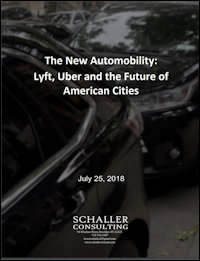As ride-hailing services Uber and Lyft have steadily gained market share, urbanists have been asking themselves, is this a good thing or bad thing? Will the increasing patronage of ride-hailing companies induce people to sell their cars? Siphon riders away from mass transit? Increase or reduce vehicle miles traveled? Make traffic congestion better or worse?
A new study by Bruce Shaller, a former New York City traffic planner, purports to have answers — and the outlook is not encouraging. In “The New Automobility: Lyft, Uber and the Future of American Cities, ” Shaller concludes that Transportation Network Companies (or TNCs):
- Have added 5.7 million miles driven in nine of America’s largest metropolitan areas (including Washington, D.C.).
- Compete mainly with public transportation, walking and biking, accounting for much of the loss in mass transit ridership. About 60% of TNC riders in large, dense cities would have walked, biked, or taken public transportation were it not for the availability of TNCs.
- Do not compete with private automobile ownership except in two main instances: to avoid drinking and driving, and when parking is expensive or a hassle.
Even shared-ride services such as UberPOOL, Uber Express POOL and Lyft Shared Rides add mileage to city streets, putting 2.8 new TNC vehicle miles on the road for each mile of personal driving removed, the report says. The trend toward autonomous cars, argues Shaller, will make matters only worse.
Summing up the implications, he says:
The new mobility has much to offer cities: convenience, flexibility, on-demand technology and a nimbleness to search for the fit between new services and inadequately served markets. But development of ride services must take place within a public policy framework that harnesses their potential to serve the goals of mobility, safety, equity and environmental sustainability. Without public policy intervention, big American cities are likely to be overwhelmed with more automobility, more traffic and less transit and drained of the density and diversity which are indispensable to their economic and social well being.
Lyft disputed Shaller’s conclusions in comments to the Washington Post.
“We strongly disagree with Schaller’s claims regarding shared rides,” Lyft spokeswoman Campbell Matthews said. “Since Lyft’s founding, we’ve been focused on increasing car occupancy and eliminating the need for car ownership. That focus has paid off.
“Just last year, over 250,000 Lyft passengers gave up their personal cars because of the availability of rideshare,” Matthews said. “We are continuing to focus on our goals by redesigning the Lyft App to integrate with public transit and introducing bike and scooter sharing to the Lyft platform. We are committed to ensuring passengers have access to a spectrum of transportation options that serve our cities best.”
Uber said in a statement that it supports several of the policies Schaller proposes, including the expansion of dedicated bus and bike lanes and congestion pricing. The company argued that contrary to Schaller’s conclusions, Uber saved more than 315 million global vehicle miles in 2017 by shifting riders to its pool service.
Bacon’s bottom line: Shaller’s should be taken seriously — but not accepted as the final word on the matter. By necessity, he makes a number of assumptions and extrapolations, which may or may not be justified. Also, his data samples are stronger for large metros than smaller metros.
But, with those cautions in mind, let us accept his conclusions as an accurate reflection of reality. What should be done? One option that Shaller discusses is to discourage personal vehicle use in congested areas by imposing trip fees or congestion pricing. Another is to restrict the number of fleet-operated vehicles to streets’ free-flow capacity. A third is to invest in more frequent bus and rail service.
Here’s my concern with Shaller’s proposals. We are still in the early stages of the new mobility revolution. Even if it’s true that TNCs are aggravating congestion now, increased market penetration and shared-ridership innovation could have non-linear effects, changing traffic dynamics in the future. Uber and Lyft are in the very early stages of developing their shared-ridership programs. One strategy they have articulated is to integrate with mass transit, using ride-sharing as a last-mile solution. If organized and promoted properly, this approach eventually could increase bus and transit ridership. Has the hold-up in forging these partnerships been the fault of Uber and Lyft — or of the lumbering bureaucracies of the mass transit companies?
What seems evident to me is that publicly owned mass transit behemoths are in desperate need of a shake-up. TNC competition can push them into innovating and adapting. Conversely, restricting TNCs will guarantee that big-metro transportation remains in a state of stasis — at tremendous ongoing expense to taxpayers in the form of mass-transit subsidies. While it’s worthwhile paying close attention to the issues Shaller raises, it is way to early to begin acting on his proposals.


Leave a Reply
You must be logged in to post a comment.